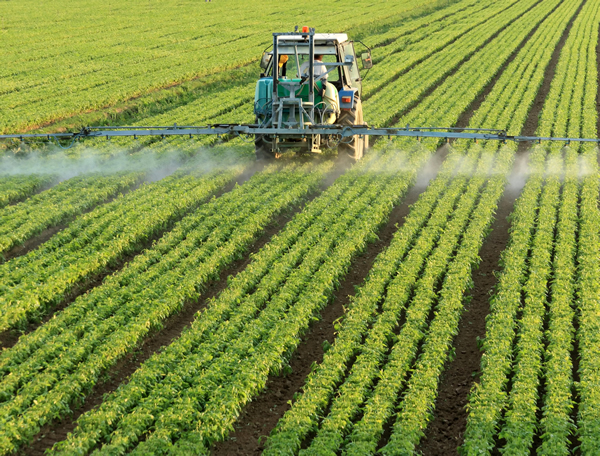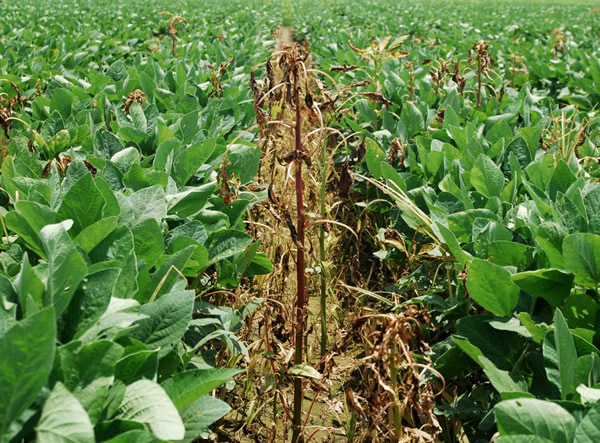 |
| Spraying herbicides |
Herbicides are a class of pesticide used to kill or otherwise control weeds and other unwanted vegetation.
Herbicides are used to control grasses, weeds, and other plant pests. These chemical compounds kill plants or inhibit their normal growth. In general, herbicides work by interfering with photosynthesis, so that a plant dies from lack of energy or by a combination of defoliation (leaf removal) and systemic herbicidal action.
Herbicides are used to clear rights-of-way beneath power lines and along railways and roads. In agriculture and forest management, they are used to control weeds or to remove the leaves from some crop plants to facilitate harvesting.
  |
While herbicides may be employed in lieu of tillage, their use is more often in conjunction with tillage and other agronomic practices. During wartime, defoliants and other herbicides have been used to destroy plants that an enemy uses for cover during battle or for food.
Types of Herbicides
Herbicides may be selective or nonselective. Selective herbicides, such as amitrole, atrazine, monuron, pyridine, 2,4-dichlorophenoxyacetic acid (2,4-D), and 2,4,5-trichlorophenoxyacetic acid (2,4,5-T), target a particular plant and will kill or stunt weeds among crop plants without injuring the crop.
For example, 2,4-D targets soft-stemmed plants, while 2,4,5-T is effective against woody plants. Cereals (grains) are crops particularly suited for treatment with 2,4-D, because the compound does not harm narrow-leafed plants but kills broad-leaved weeds. Selective toxicity minimizes the environmental impact of an herbicide.
Nonselective herbicides (also called broad-spectrum or general-usage herbicides) are toxic to all plants. Examples include dinoseb, diquat, paraquat, and arsenic trioxide. Non selective compounds are best suited for areas where all plant growth is to be suppressed, such as along railroad rights-of-way.
Some compounds, known as contact herbicides, kill only those plant parts to which they are directly applied. Others, called systemic herbicides, are absorbed through the plant’s foliage or roots and carried to other parts of the plant. When mixed with the soil, some herbicides kill germinating seeds and small seedlings.
 |
| Herbicide effects |
Popular inorganic herbicides include ammonium sulfate, sodium chlorate, sulfuric acid solutions, and borate formulations. Among the organic herbicides are the organic arsenicals, substituted amides and ureas, nitrogen heterocyclic acids, and phenol derivatives. Phenoxyaliphatic acids and their derivatives, a major group of organic herbicides, are selective poisons that readily travel from one part of a plant to another.
History
Agricultural societies have used simple chemical herbicides, such as ashes and common salts, for centuries. In 1896 a fungicidal compound known as Bordeaux mixture (a combination of copper sulfate, lime, and water) was found to be effective against some weeds.
Subsequently, copper sulfate was employed as a selective weed killer in cereal crops. By the early 1900’s sodium arsenate solutions and other selective inorganic herbicidal mixtures had been developed.
In the early 1940’s a new generation of herbicidal compounds emerged. In an attempt to mimic natural plant hormones, the defoliant 2,4-D was created. At low concentrations, 2,4-D promotes retention of fruit and leaves; at higher concentrations, it over stimulates plant metabolism, causing leaves to drop off. A related chemical, 2,4,5-T, came into general use in 1948.
The years after World War II saw the first large-scale application of herbicides in agriculture and other areas. The new defoliants rapidly gained acceptance because of their effectiveness against broad-leaved weeds in corn, sorghum, small grains, and grass pastures.
   |
A few years after their development, these defoliants were employed as chemical weapons. During its conflict with communist guerrillas in Malaya during the late 1940’s and early 1950’s, Britain sprayed 2,4,5-T on crops and jungle foliage to deprive the guerrillas of food and cover.
The United States conducted a similar anti food and anti foliage campaign in South Vietnam during the 1960’s. In this campaign, dubbed Operation Ranch Hand, massive quantities of herbicidal mixtures were sprayed from aircraft onto Vietcong food plantations, infiltration routes, staging areas, and bases.
The quantity and frequency of the spraying greatly exceeded recommended levels; in addition, mechanical problems or military need often forced aircraft to dump their herbicide loads all at once, drenching the jungle below. Soldiers, civilians, and the environment were subjected to unusually high concentrations of defoliants.
One of the herbicides used in this campaign was Agent Orange, a mixture that included 2,4-D and 2,4,5-T. Commercial preparations of 2,4,5-T contain varying amounts of dioxin, a highly toxic contaminant.
Agent Orange has been implicated in the increased incidence of still births and birth defects among the Vietnamese living in the areas sprayed, in illnesses suffered by American and Australian soldiers who were involved in the operation, and in birth defects among the children of these veterans. In 1970 the United States placed severe restrictions on domestic and agricultural use of 2,4,5-T, at about the same time the defoliation campaign was halted.
U.S. Regulation of Herbicides
 |
| Field spray |
In 1947 the Federal Insecticide, Fungicide, and Rodenticide Act (FIFRA) authorized the U.S. Department of Agriculture (USDA) to oversee registration of herbicides and other pesticides and to determine their safety and effectiveness.
In December, 1970, the newly formed Environmental Protection Agency (EPA) assumed statutory authority from the USDA over pesticide regulations. Under the Federal Environmental Pesticide Control Act of 1972, an amendment to FIFRA, manufacturers must register all marketed pesticides with the EPA before the product is released.
Before registration, the chemicals must undergo exhaustive trials to assess their potential impact on the environment and human health. An EPA decision to grant registration is based on the determination that unreasonable adverse effects on human health or the environment are not anticipated within the constraints of approved usage.
Since October, 1977, the EPA has classified all pesticides to which it has granted registration as either restricted-usage (to be applied only by certified pest control operators) or unclassified (general-usage) pesticides.